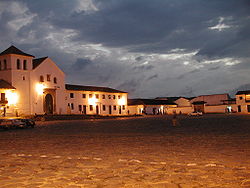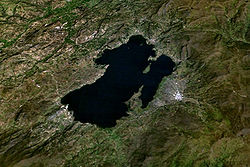Boyacá Department
Department of Boyacá
Departamento de Boyacá | |
|---|---|
|
UTC-05 | |
| ISO 3166 code | CO-BOY |
| Provinces | 13 |
| Municipalities | 123 |
| HDI (2019) | 0.760[5] high · 12th of 33 |
| Website | Official website |
| Year | Pop. | ±% |
|---|---|---|
| 1973 | 1,077,361 | — |
| 1985 | 1,209,739 | +12.3% |
| 1993 | 1,315,579 | +8.7% |
| 2005 | 1,255,311 | −4.6% |
| 2018 | 1,217,376 | −3.0% |
| Source:[6] | ||
Boyacá (Spanish pronunciation: [boʝaˈka]) is one of the thirty-two departments of Colombia, and the remnant of Boyacá State, one of the original nine states of the "United States of Colombia".
Boyacá is centrally located within Colombia, almost entirely within the
Boyacá is known as "The Land of Freedom" because this region was the scene of a series of battles which led to Colombia's independence from Spain. The first one took place on 25 July 1819 in the Pantano de Vargas and the final and decisive battle known as the Battle of Boyacá was fought on 7 August 1819 at Puente de Boyacá.
Boyacá is home to three
Origin of the name
The word Boyacá derived from the Chibcha word "Bojacá" which means "Near the cacique", or "Region of the royal mantle".
History

The territory of present-day Boyaca was during the
.The first European to discover the area was the Spaniard Gonzalo Jiménez de Quesada who conquered the northern Muisca living in the area led by last zaque Aquiminzaque and distributed the land in encomiendas and forced the indigenous people to work for him.
In 1539, Gonzalo Suárez Rendón, a Spanish conquistador, founded the city of Tunja and other sites where the indigenous people previously had their villages. Tunja became one of the main political and economic centers for the Spanish during the Viceroyalty of New Granada.
During the 19th century, Boyacá was battleground for numerous confrontations between the
After the creation of the
Geography



Boyacá is located in the
The department of Boyacá covers a small portion of the
.The Altiplano Cundiboyacense, shared with the department of Cundinamarca, is densely populated with numerous valleys. The southern part is the Bogotá savanna. Boyacá is subdivided into 123 municipalities.
Many rivers originate in Boyacá, the most important are the Chicamocha River and Arauca River and tributaries to other important rivers such as the Magdalena and Meta.
Boyacá also has numerous lakes which include Lake Tota, Lake Sochagota and Lake Fúquene, shared with the department of Cundinamarca, the artificial Chivor Reservoir and others.
National parks
El Cocuy and Pisba National Parks are located in the northeast of Boyacá. Pisba National Park is shared with the department of Arauca. The flora and fauna sanctuary of Lake Iguaque is situated in the centre of the department. The most beautiful páramo in the world, Ocetá Páramo, is in northeast Boyacá.
Climate

The central area of the highlands has two rainy seasons; the first between April and June, and a second between October and November with an average of 1,000 millimetres (39 in) of rainfall per year. The rest of the year is considered to be the dry seasons with intermittent rainfall.
Provinces and municipalities



There are 13 provinces and two special districts in the Boyacá Department, listed below with their 123 municipalities. The department also has 123
Municipalities are also grouped into 45 notary circuits with 53 notaries public. One circuit main registry based in the capital of the department; Tunja and 13 other minor registries spread across the territory.
Central
NorthernWestern
Eastern |
Gutiérrez
La Libertad
LengupáMárquezNeiraRicaurte |
SugamuxiTundamaValderrama
|
See also
- Postage stamps of Boyacá
References
- ^ a b "Boyacá Nuestro Departamento: Localización: Posición Geográfica". Gobernación del Boyacá. Archived from the original on 14 January 2013.
- ^ ISBN 978-1-85743-541-2.
- ^ "Estimaciones de Población 1985 – 2005 y Proyecciones de Población 2005 – 2020 Total Municipal por Área (estimate)". Departamento Administrativo Nacional de Estadística. Retrieved 29 March 2014.
- ^ "Producto Interno Bruto por departamento", www.dane.gov.co
- ^ "Sub-national HDI – Area Database – Global Data Lab". hdi.globaldatalab.org. Retrieved 13 September 2018.
- ^ "Reloj de Población". DANE. Departamento Administrativo Nacional de Estadísitica. Archived from the original on 16 January 2018. Retrieved 6 July 2017.
- ^ "Boyacá Nuestro Departamento: Aspectos Geográfícos". Gobernación del Boyacá. Archived from the original on 14 January 2013.
External links
- (in Spanish) Excelsio – journal from Boyacá
